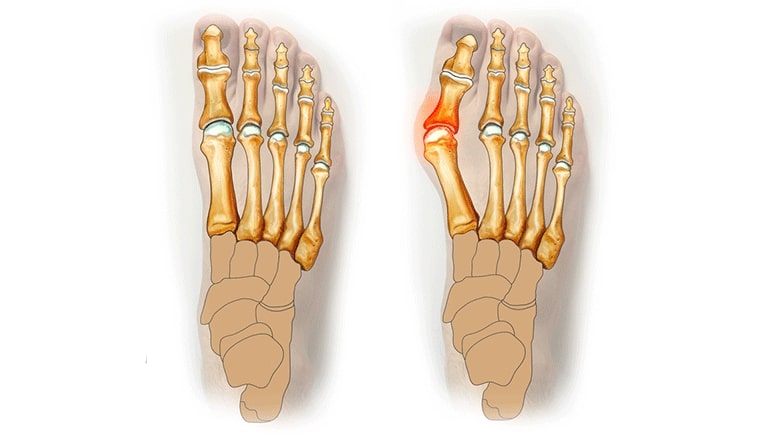Hallux Valgus: Understanding This Big Toe Deformity
What is Hallux Valgus?
Hallux valgus is a deformity of the first toe (big toe) causing it to deviate laterally towards the other toes. It's more common in women than men (10 times more prevalent) and often hereditary.
It usually involves dislocation of the sesamoid bones, two small bones within the big toe joint.
What Causes Hallux Valgus?
There are two main causes of hallux valgus:
- Congenital Cause: Individuals with a longer big toe compared to other toes are more prone to developing hallux valgus. The same is true for those with flat feet and adducted forefoot;
- Acquired or Secondary Cause: The most frequent cause is often wearing inappropriate footwear. Poorly fitting shoes force the big toe into an unnatural position and hinder proper foot movement while walking;
Who is Affected by Hallux Valgus?
Anyone can experience hallux valgus, but it's more common in women and tends to appear at an older age or in senility. Women are disproportionately affected, with a ratio of 15:1 compared to men. Recent data suggests approximately 40% of women in Europe suffer from hallux valgus. It can occur at any age, but peaks around 40-50 years old.
GET A QUOTE
Need more information?
Your health, our priority.
Request your free quote
Diagnosing Hallux Valgus
Diagnosing hallux valgus is usually straightforward, often self-diagnosed by the patient even before a specialist examination. Analyzing its causes, which can vary, is more complex. For accurate diagnosis, in addition to a clinical foot assessment, a weight-bearing radiograph (standing position), preferably bilateral, is helpful to check for differences and asymmetries.
Symptoms of Hallux Valgus
Hallux valgus is characterized by toe displacement: some experience greater discomfort in the second toe, others directly in the big toe, while some experience severe generalized hallux valgus pain even without significant malformation.
Common symptoms generally include:
- Big toe visibly displaced towards the second toe, with swelling at and around its base;
- Skin thickening at the base of the big toe, with a red, swollen area;
- Continuous or intermittent pain;
In severe cases, the big toe may overlap the second toe, causing even more pain and disability.

Hallux Valgus: At-Risk Individuals and Risk Factors
Anyone can be affected by hallux valgus, but it's more common in women. It tends to appear more frequently at an older age or in senility. Additionally, individuals with congenital foot abnormalities (e.g., flat feet) are more likely to develop hallux valgus during growth. There are also predisposing factors related to positive family history (heredity), particularly in cases of juvenile hallux valgus.
Certain diseases, such as rheumatoid arthritis and gout, can also lead to hallux valgus. Several other conditions increase vulnerability, such as the length of the first metatarsal, hypermobility of the metatarsal joint, low muscle tone, certain neuromuscular diseases, and connective tissue disorders (like Marfan syndrome).
Preventing Hallux Valgus
Several exercises can help manage or prevent worsening of the deformity, but before starting any method, consult a doctor who, after diagnosis, will develop a therapy suited to each case.
The remedies mentioned below should be considered general suggestions and should be followed after medical consultation.
The first suggestion concerns footwear: always choose comfortable shoes, avoiding high heels or flip-flops.
Postural rehabilitation is also essential to regain your center of gravity and walk in a way that distributes your weight evenly across your feet.
Postural exercises can be helpful in many situations, not only preventing hallux valgus but also reducing scoliosis or managing bone pain.
If hallux valgus has already manifested with minor symptoms (remember it's also visually noticeable), it's advisable to limit its progression using separators and straps. These tools help keep the toes properly spaced.
Treating Hallux Valgus
Medical Treatments
Hallux valgus treatment is divided into two main modalities: conservative and surgical.
The first aims to relieve painful symptoms but cannot correct the deformity. It involves using appropriate footwear with a flexible upper, a wide sole, and a heel no higher than 4 cm.
In mild deformities, hallux valgus orthotics may be indicated, but they are ineffective, even counterproductive, in severe deformities.
According to an article published in the Journal of Orthopaedics and Traumatology, the use of interdigital separators or retractors has no proven clinical efficacy except to reduce the conflict between the first and second toes.
Examinations
For this pathology, imaging examinations such as ultrasound, MRI, and CT scans are of little use as they are most often performed in a supine position.
This position does not provide relevant information on how the skeleton and soft tissues react in a standing position.
Functional examinations, such as stabilometric tests or gait analysis, while not providing additional discriminatory information, can be useful later to monitor the effectiveness of the chosen treatment and its potential influence on adjacent joints and body areas.
Surgical Treatment for Hallux Valgus
Hallux Valgus: When to Operate?
Surgical treatment is the most effective solution for severe deformities and should be evaluated based on an analysis of the patient's condition. The orthopedist will then determine the surgical technique and the type of hallux valgus operation to be performed. Hallux valgus surgery can be performed using open surgery or percutaneous surgery (less invasive treatment).